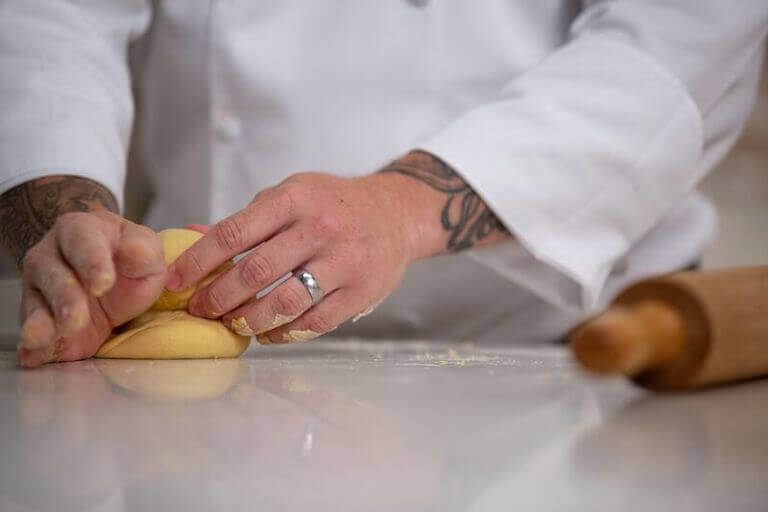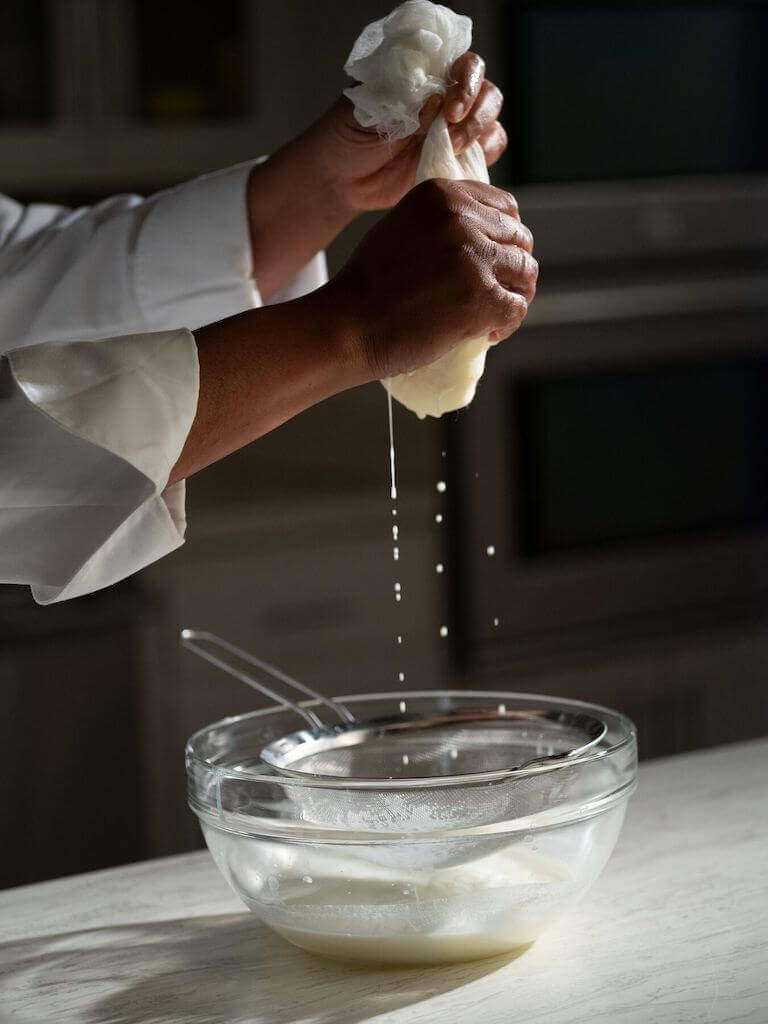You’ve most likely grabbed a box of dried pasta, thrown it into a pot of boiling water, and sat down to dinner just a few minutes later…but have you ever made your own pasta from scratch?
Making fresh pasta isn’t as intimidating as it sounds, especially when you have a chef guiding you along the way. Chef Dan Bearss recently explained how to make spinach ravioli, so you can mix up a batch of homemade pasta at home.
How to Make Spinach Ravioli
Make the Spinach and Crème Fraîche Filling
The first step to making your ravioli is mixing up the filling so it can chill.
Ingredients
- 1 cup crème fraîche
- 12 ounces fresh spinach
- 1 large egg
- ½ cup grated Parmesan cheese
- ¼ cup garlic, finely chopped
- 1 tbsp olive oil
- 1 tbsp kosher salt
- 2 tsp freshly ground black pepper
Instructions
1. Bring a pot of water to a simmer and place all spinach in the water for 30 seconds. Strain and then run the spinach under cool water for 30 seconds. Let the spinach dry.
2. Place crème fraîche in a fine mesh strainer lined with cheesecloth, and then lightly press on the cheese with the back of a spoon to remove excess liquid.
3. Add one tablespoon of olive oil to a small saucepan and then place on medium heat. Sauté the finely minced garlic until aromatic and lightly golden brown.
4. Mix all ingredients in a bowl until evenly incorporated. Cover in plastic wrap and chill for at least two hours or overnight.
Make Fresh Egg Pasta
Once your filling is chilling, you can turn your attention to making the fresh pasta. While this pasta dough will be used to make ravioli, you can also use the dough to make a variety of different pasta shapes.
Ingredients
- 1 lb bread flour
- 5 eggs
- ½ fl oz olive oil
- Pinch of salt

Instructions
1. Mound the flour on a clean work surface such as a counter or cutting board. Make a well in the center then add the eggs, oil, and salt.
2. Working from the center outward, use your hands to mix the flour into the eggs until the ingredients are well incorporated.
3. When the dough is firm enough to knead, begin kneading it while incorporating more flour. If the dough is still sticky when all the flour is incorporated, add more flour–a little at a time. Knead well for at least 15 minutes.
4. Cover the dough and let it rest at least 30 minutes at room temperature.
5. Cut the dough into three to five pieces. Set the rollers of a pasta machine at the widest opening. Pass the pieces of dough through the machine, folding them in thirds after each pass and dusting them lightly with flour to keep them from getting sticky. Continue passing each piece through the machine until it is smooth. (If you don’t have a pasta machine, you can use a rolling pin for this process.)
6. Working with one piece of dough at a time, decrease the width between the rollers one notch and pass the dough through them again. After each pass, turn the rollers one notch narrower, dust the dough with flour, and pass it through again. Continue until the dough is as thin as desired.
“My chefs are always right there to help me with any questions I have. And when they grade assignments, they see every step and can help determine what you did right, what you did wrong, and what you need more practice on. You literally have a team of people there for you to help you every step of the way.”*
Brianna Burroughs, Escoffier Online Culinary Arts student
Make the Ravioli
With the filling and pasta complete, it’s time to form your ravioli.
Ingredients
- 2 cups ravioli filling
- 8 pasta sheets rolled into thin strips measuring 5” wide by 9” long
Instructions
1. Bring a pot of salted water to a boil and then reduce to a simmer.
2. Lightly dust your work surface with flour and lay out one sheet of pasta. Use a spoon to place two tablespoons of filling every two inches. You should end up with two rows of four spoonfuls.
3. Lay the second pasta sheet evenly over the first sheet, covering the filling. Lightly mold the top pasta sheet around each section of the filling to create eight distinct mounds.
4. Use a knife to cut the pasta sheets into eight even square ravioli.
Try Out Different Shapes
Along with square ravioli, you can also make half-moons (as Chef Bearss does in the instructional video) or create round ravioli.
5. Using a fork, press the tines into the outer edge to create ridges and seal the pasta around the filling.
6. Place the ravioli on a sheet tray and repeat steps 2-5 a total of three more times to create all 32 ravioli.
7. To avoid overcrowding the pot, place the ravioli in batches into the boiling water. Boil two to three minutes, and remove the ravioli when they float to the top of the pot.
8. Strain and pair your pasta with a complementary sauce such as Alfredo or marinara.
Tips to Make Perfect Ravioli
Take note of these helpful tips when making your spinach ravioli.
Thoroughly Drain All Filling Ingredients
Both spinach and crème fraîche are filled with moisture that can potentially lead to a soggy filling. In order to create a filling that’s filled with flavor rather than excess moisture, you’ll need to squeeze the excess water from both the crème fraiche and the spinach.
One of the best ways to remove moisture is to place the ingredient in the middle of a piece of cheesecloth, bring the four corners together, and then tightly twist the top until moisture begins to escape.

Remember Fresh Pasta Cooks More Quickly Than Dried Pasta
While dried pasta has to rehydrate before it cooks, fresh pasta is already full of moisture. Therefore, it will cook much faster than its dried equivalent.
Remove your ravioli as soon as they float to the top to ensure perfectly al dente pasta.
Firmly Seal the Edges
To prevent the filling from escaping from the pasta, you’ll need to create a solid seal. If you’re pleating your pasta with a fork, press the prongs firmly into the pasta until you see distinct lines.
Once the pasta is cooked, you won’t be able to fix any imperfect seals or pleatings, so be sure to do it right from the beginning!
Continue Advancing Your Culinary Skills
If you’ve enjoyed learning how to make fresh spinach ravioli, you may enjoy exploring new culinary techniques and recipes in culinary school.
Escoffier’s Culinary Arts programs are taught by Chef Instructors such as Chef Bearss. Not only can they help you explore new techniques, but they might also help you discover a new passion.
To learn more about our programs, contact us today.
To learn more about recipes and culinary techniques, check these out next:
- Modern Food Plating Tips: A Colorful Dessert Recipe for Spring
- 4 Advanced Cooking Methods for Every Chef
- How to Make Brown Butter and Sage Gnocchi
*Information may not reflect every student’s experience. Results and outcomes may be based on several factors, such as geographical region or previous experience.

